Fery
International Hazard
    
Posts: 1026
Registered: 27-8-2019
Location: Czechoslovakia
Member Is Offline
|
|
alpha and beta ionone by cyclization of pseudoionone
Pseudoionone undergoes cyclization reaction using 85% H3PO4 into alpha ionone and using a mixture of 70 wt.% conc. H2SO4 + 30 wt.% glacial acetic acid
into beta ionone. It is possible to rearrange alpha and gamma ionone into most thermodynamically stable beta. Beta is obtained in high purity. When
cyclizing into alpha, it contains also some beta and gamma so here it is necessary to keep temperatures and reaction time to obtain as much of alpha
as possible and reduce rearrangement into beta.
here materials to study:
https://bpb-us-e1.wpmucdn.com/sites.ucsc.edu/dist/9/291/file...
Attachment: Exp-3-Synthesis-of-Ionones-1gqxp8q.pdf (1.3MB)
This file has been downloaded 203 times
https://sci.bban.top/pdf/10.1021/ie50437a028.pdf#view=FitH
Attachment: ie50437a028.pdf (410kB)
This file has been downloaded 144 times
https://sci.bban.top/pdf/10.1021/ja01666a017.pdf#view=FitH
Attachment: ja01666a017.pdf (773kB)
This file has been downloaded 127 times
To synthesize pseudoionone from citral and acetone read this:
https://www.sciencemadness.org/whisper/viewthread.php?tid=16...
[Edited on 11-12-2023 by Fery]
|
|
|
Fery
International Hazard
    
Posts: 1026
Registered: 27-8-2019
Location: Czechoslovakia
Member Is Offline
|
|
alpha ionone
Put magnetic stir bar into 100 ml RBF, pour there 70 g 85% H3PO4 (density 1,71 g/ml = 40 ml), cooled to 15 C.
Add there 9,0 g pseudoionone dropwise from 10 ml medicinal syringe during 10 minutes, T raises to 35 C (if higher T reached, then cool down to 35 C).
Keep stirring at high RPM at 35 C for 25 minutes or at 30 C for 30 minutes (mixture is quite thick and dark). During 25 minutes the T continually
drops from 35 to 30 C.
(It could be also possible to use a water bath of 30 C for 30 minutes).
Pour the reaction mixture into 500 ml beaker with 50 g of snow, then add 50 ml of water and 20 ml of isohexanes and after the snow melts, transfer
into 250 ml separatory funnel.
Keep aside the upper organic phase.
Extract bottom water phase with 10 ml isohexanes.
Connect both organic phases.
Wash 2x 50 ml 5% NaHCO3 (copious CO2 evolution !!!!!!!)
Drain into 250 ml flask (Erlenmeyer was used due to larger bottom which facilitates evaporation, but RBF could be used too). Add boiling stones and
distill out isohexanes (b.p. 60-65 C) on not too much hot hotplate (100-120 C is enough).
Cool down and add 150 ml of water, distill using Clevenger apparatus (it is similar to Dean-Stark trap which returns upper phase back into the
distilling flask, Clevenger returns back the bottom phase). Drain and discard first 5 ml of distillate collected (reminders of isohexanes + water).
The product separates as yellowish oil floating atop of water layer. If you do not have Clevenger, it could be perhaps possible to use also simple
condenser and collect a lot of water hydrodistillate (ionone is only very low soluble in water, cca 0,1 mg per 1 ml). The hydrodistillation lasts
about 4 hours using 150 W heating mantle at full power and I approximate the volume of water distilled could be more than 1 liter for 5 ml of the
product obtained. It has beautiful scent of flowers. Pity that I didn't the synthesis while ago. Definitely so far the best aroma I have synthesized
in my life.
The reaction, it gets the dark red color from the beginnig and becomes quite thick so use powerful stirrer and at least medium sized stir bar
(certainly do not use small one as the small stir bar could stir only the bottom and not the whole volume !!!). The piece of plastic sheet covering
the mouth of the flask is there just to reduce absorbing water from air and prevent splashing (but the reaction was so thick that no splashing
observed although stirring at highest possible RPM).
 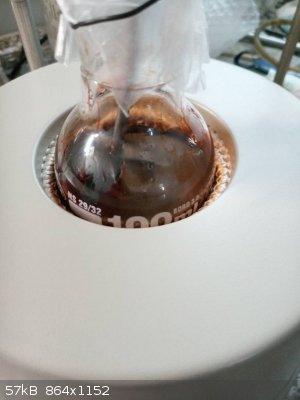
Reaction mixture poured into snow, added water and isohexanes.
 
Keep upper organic phase using sep. funnel.

Extract bottom phase with isohexanes for one more time.

Connect both organic phases and wash with 50 ml of 5% NaHCO3. Note copious CO2 evolution !!!!!!!!!!!!
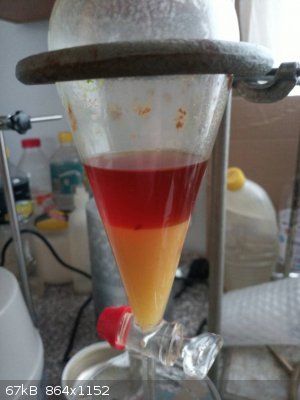
Wash again with 50 ml of 5% NaHCO3. Only little of CO2 evolution.
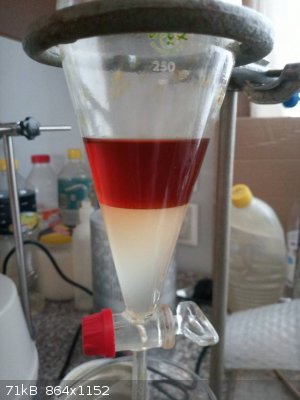
There is no need to dry the organic phase (it is going to be hydrodistilled). Just distill out isohexanes.
  
Cool down, add 150 ml of water, boiling stones and hydrodistill using Clevenger apparatus. Discard first 5 ml of the distillate (remainders of
isohexanes + water) - 3rd photo.
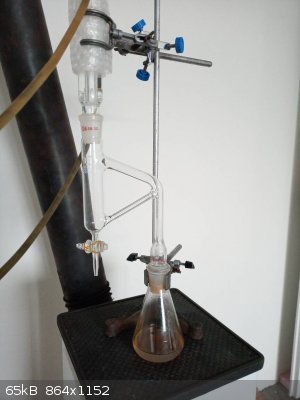  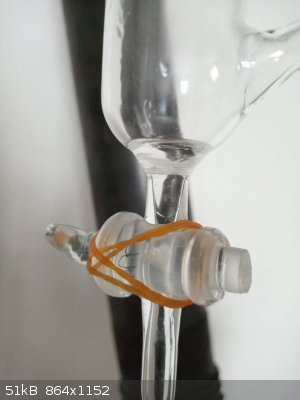
The apparatus has to be moved to more powerful heating source (150 W heating mantle at full power + magnetic stirring to prevent bumping and
emulsifying the oily product into smaller droplets). The product separates as yellowish oil floating atop of water phase. 5 ml obtained after 4 hours
of distillation.
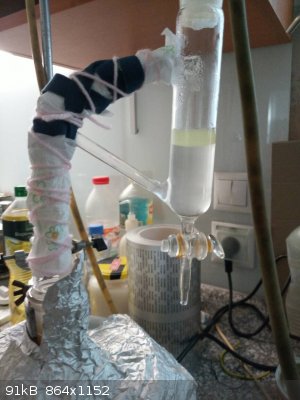
|
|
|
Fery
International Hazard
    
Posts: 1026
Registered: 27-8-2019
Location: Czechoslovakia
Member Is Offline
|
|
beta ionone
Mix 35 g 96% H2SO4 + 15 g glacial acetic acid in 100 ml RBF. It little heats very likely due to small amount of water in the acetic acid (but not too
much, the flask could be touched with hand). Cool down in snow / water bath to 10 C.
Using 10 ml medicinal syringe, add 9,2 g pseudoionone dropwise during 10 minutes while magnetic stirring and cooling the flask to keep the T in 10-15
C range, not to exceed 20 C. After the addition of all the pseudoionone, remove cooling bath and vigorously stir at high RPM at 20 C for 20 minutes
(the mixture is black and much darker and also more viscous than when using 85% H3PO4 for alpha). The reaction seems to be at least little more
exothermic than alfa ionone preparation - the beta ionone is the most thermodynamically stable isomer and alfa could be isomerized into beta too.
Pour into 100 g of snow in 500 ml beaker. Repeatedly add a little of snow and 20 ml of isohexanes in portions into the reaction flask to obtain
remainders of the thick product adhering to the wall of the reaction flask and pour everything into the beaker. After the snow melts, transfer into
separatory funnel (the T is few degrees below zero).
The rest of the work is similar to alpha ionone.
Cooling the mixture of 70 wt.% H2SO4 + 30 wt.% acetic acid.
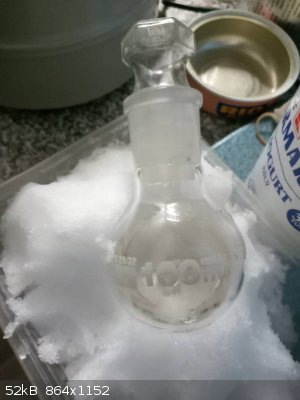
Before addition of pseudoionone.

After first and second drop of pseudoionone.
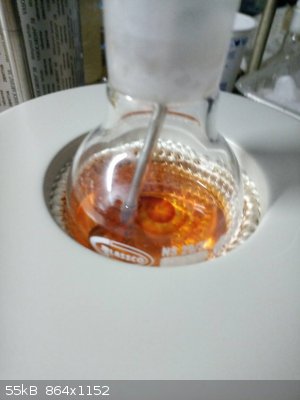 
After more drops of pseudoionone. It had to be transferred into snow-water bath when the T reached 15 C. In the bath the reaction was kept at 10-15 C
while vigorously stirring the very viscous mixture.

The reaction was done after magnetic stirring at 20 C for 20 minutes at highest possible RPM with appropriate size stir bar (medium size necessary,
small one would not stir the whole volume, just the bottom).

Pouring into 100 g of snow in 500 ml beaker. A little of snow was later repeatedly added into the RBF followed with 20 ml of isohexanes in portions to
obtain also remainders of the very viscous product adhering on the walls of the flask.

Keep upper organic phase.
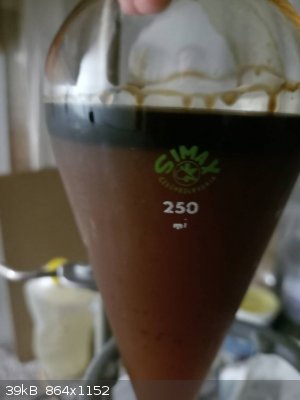
Extract bottom phase with 10 ml of fresh isohexanes.
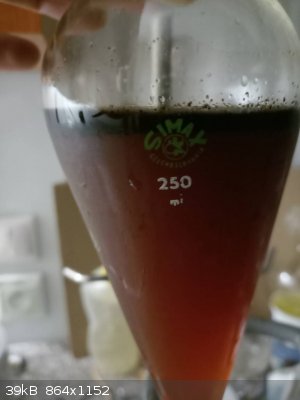
The rest of the work is similar to alpha ionone.
[Edited on 11-12-2023 by Fery]
|
|
|
Bedlasky
International Hazard
    
Posts: 1241
Registered: 15-4-2019
Location: Period 5, group 6
Member Is Offline
Mood: Volatile
|
|
Great work Fery, as always! It's always pleasure to read your detailed procedures.
|
|
|